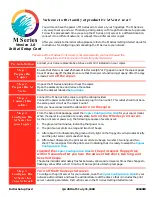
Electrostatic discharge
Electrostatic discharge
Be aware of the precautions you must follow when setting up the system or handling components. A discharge of static electricity from a
finger or other conductor may damage system boards or other static-sensitive devices. This type of damage may reduce the life
expectancy of the system or component.
To prevent electrostatic damage:
Avoid hand contact by transporting and storing products in static-safe containers.
Keep electrostatic-sensitive parts in their containers until they arrive at static-free workstations.
Place parts on a grounded surface before removing them from their containers.
Avoid touching pins, leads, or circuitry.
Always be properly grounded when touching a static-sensitive component or assembly. Use one or more of the following methods
when handling or installing electrostatic-sensitive parts:
Use a wrist strap connected by a ground cord to a grounded workstation or computer chassis. Wrist straps are flexible straps
with a minimum of 1 megohm ±10 percent resistance in the ground cords. To provide proper ground, wear the strap snug against
the skin.
Use heel straps, toe straps, or boot straps at standing workstations. Wear the straps on both feet when standing on conductive
floors or dissipating floor mats.
Use conductive field service tools.
Use a portable field service kit with a folding static-dissipating work mat.
If you do not have any of the suggested equipment for proper grounding, have an authorized reseller install the part.
For more information on static electricity or assistance with product installation, contact an authorized reseller.
Electrostatic discharge
44
Summary of Contents for Synergy 12000 Frame
Page 36: ...Customer self repair 36...
Page 37: ...Customer self repair 37...
Page 38: ...Customer self repair 38...
Page 39: ...Customer self repair 39...
Page 40: ...Removal and replacement procedures Removal and replacement procedures 40...
Page 53: ...HPE Synergy Console connections HPE Synergy Console connections 53...
Page 78: ...To replace the component reverse the removal procedure Removing and replacing a rear cage 78...
Page 82: ...Component and LED identification Component and LED identification 82...
Page 84: ...Information pull tabs 84...
Page 88: ...Figure 5 Optional horizontal half shelf Device bay partitions 88...
Page 92: ...Appliance bay numbering Appliance bay numbering 92...
Page 131: ...Specifications Specifications 131...
Page 134: ...Support and other resources Support and other resources 134...
















































